Financial Close Manager
A solution for Accountants to securely and confidently lock financial data.

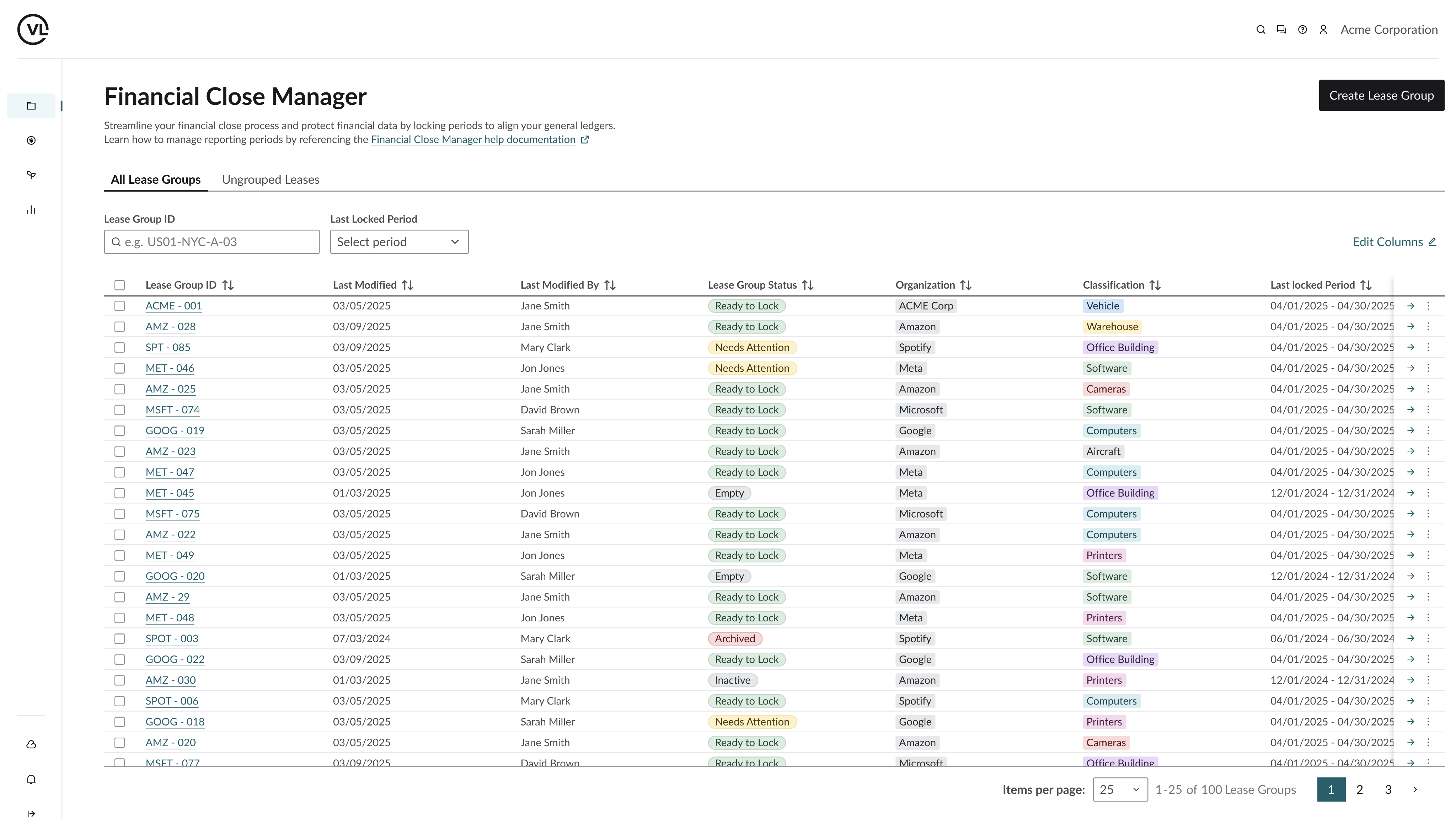
Objective
Understand users needs around period locking controls and create a solution that preserves historical financial data for accurate reporting and reconciliation.
My Role
Discovery Research
Ideation
Product Design
Testing and Validation
Post Launch Activities
Cross Collaboration
Product Design
Product
Engineering
Tools
Figma
Figjam
Microsoft Word
EnjoyHQ
Xminds
Teams
The Challenge
Today, Visual Lease users can change financial data at any time due to a lack of accounting controls that ensure data integrity. This introduces compliance risk and complicates audit readiness. Users need a reliable way to lock historical data and control what can be changed.
Customer Requests
47% of customers submitted support requests or feedback specifically asking for a period locking feature.
Changes Before Locking Periods
On average, users made 12+ changes per quarter to historical periods, increasing risk of audit discrepancies.
Audit and Compliance Impact
According to Deloitte, lack of locking controls is one of the top 3 reasons for failed audits in accounting firms.
Period Locking Adoption in Accounting Software
95% of leading ERP systems include period locking as a core feature to preserve data integrity.
The Solution

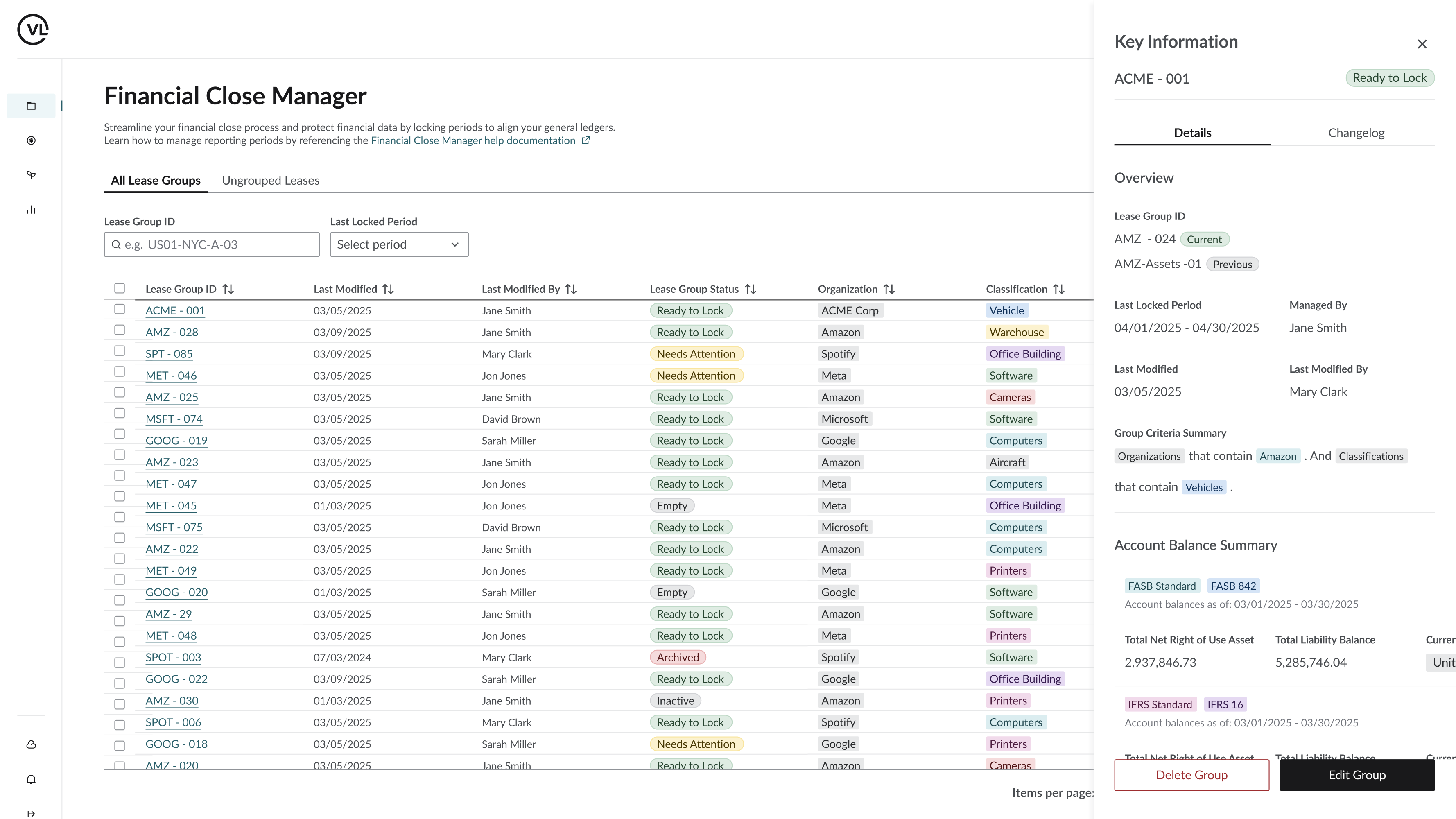
The Financial Close Manager is centralized period locking solution for accountants. It streamlines the period closing process by securing financial data, ensuring audit readiness, and supporting accurate reporting by letting users lock historical periods.
Key Features
Secure Locking Controls
PROTECTING DATA ACCURACY
Periods can be locked to prevent edits to financial data once reviewed and approved. Only authorized users can apply locks, and multiple periods can be locked at once for efficiency. This ensures users can't make changes to finalized data, reducing the risk of errors or rework.
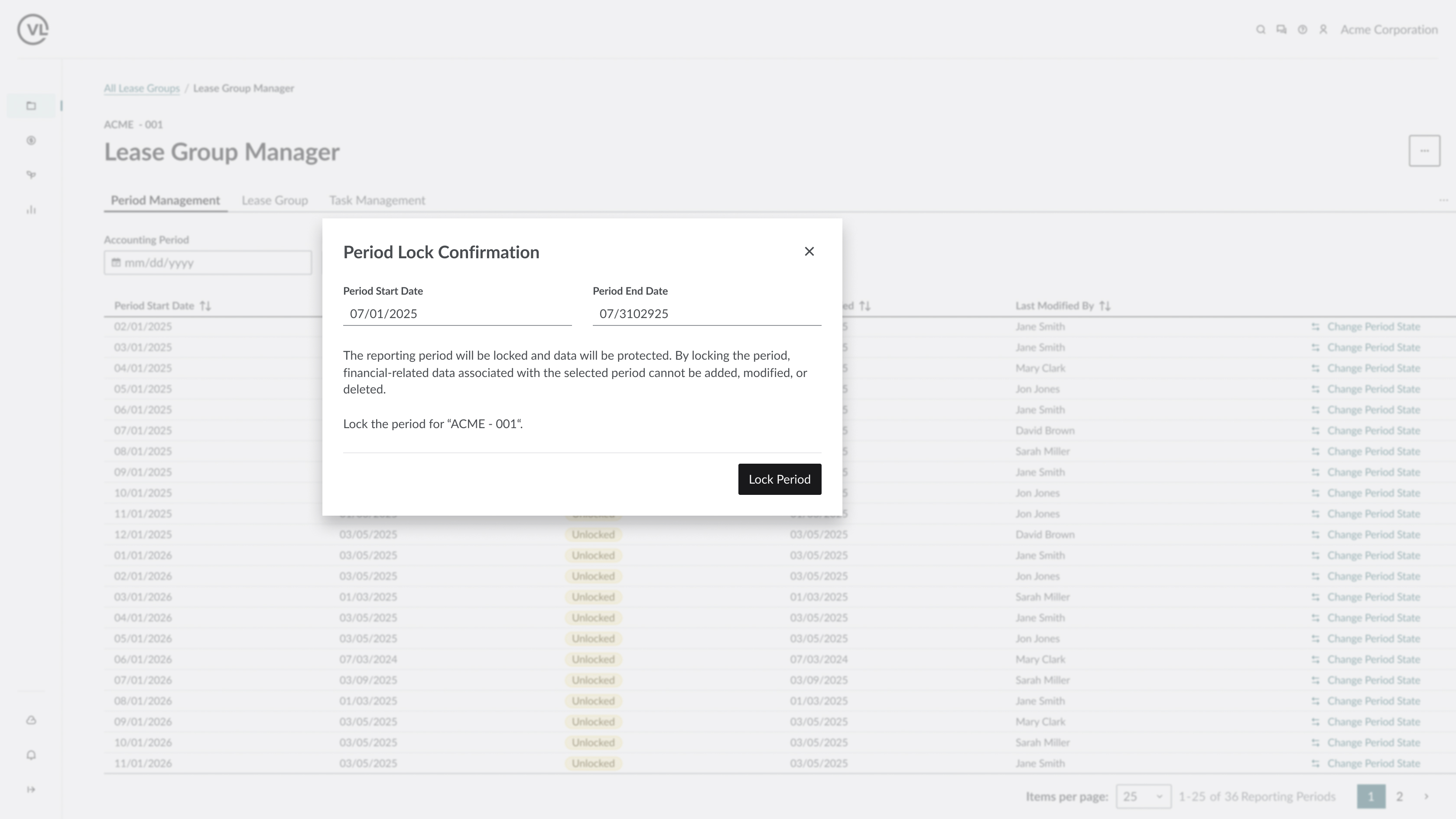
Controlled Lease Groups
MANAGING LEASES WITH PRECISION
Leases are grouped into customizable sets based on business rules or reporting structure. This enables users to lock and manage periods for specific lease groups without affecting others, supporting more flexible and targeted close workflows.
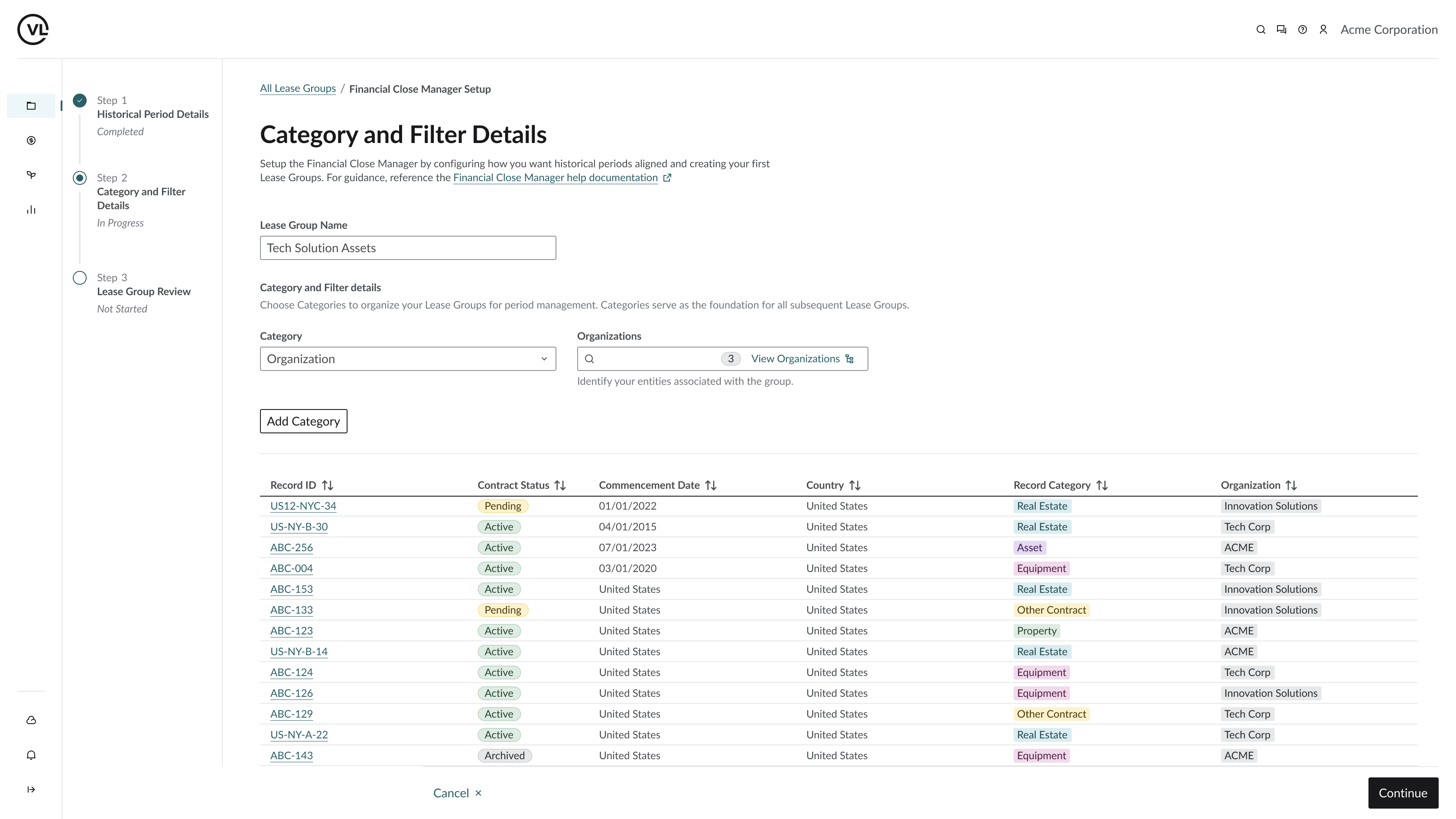
Account Balance
VERIFYING FINANCIAL ALIGNMENT
Displays key account balances at period close, helping users confirm totals match their ERP system. When balances align, users gain confidence to proceed with closing without the need to unlock or revise later — minimizing disruption and ensuring a smoother process.
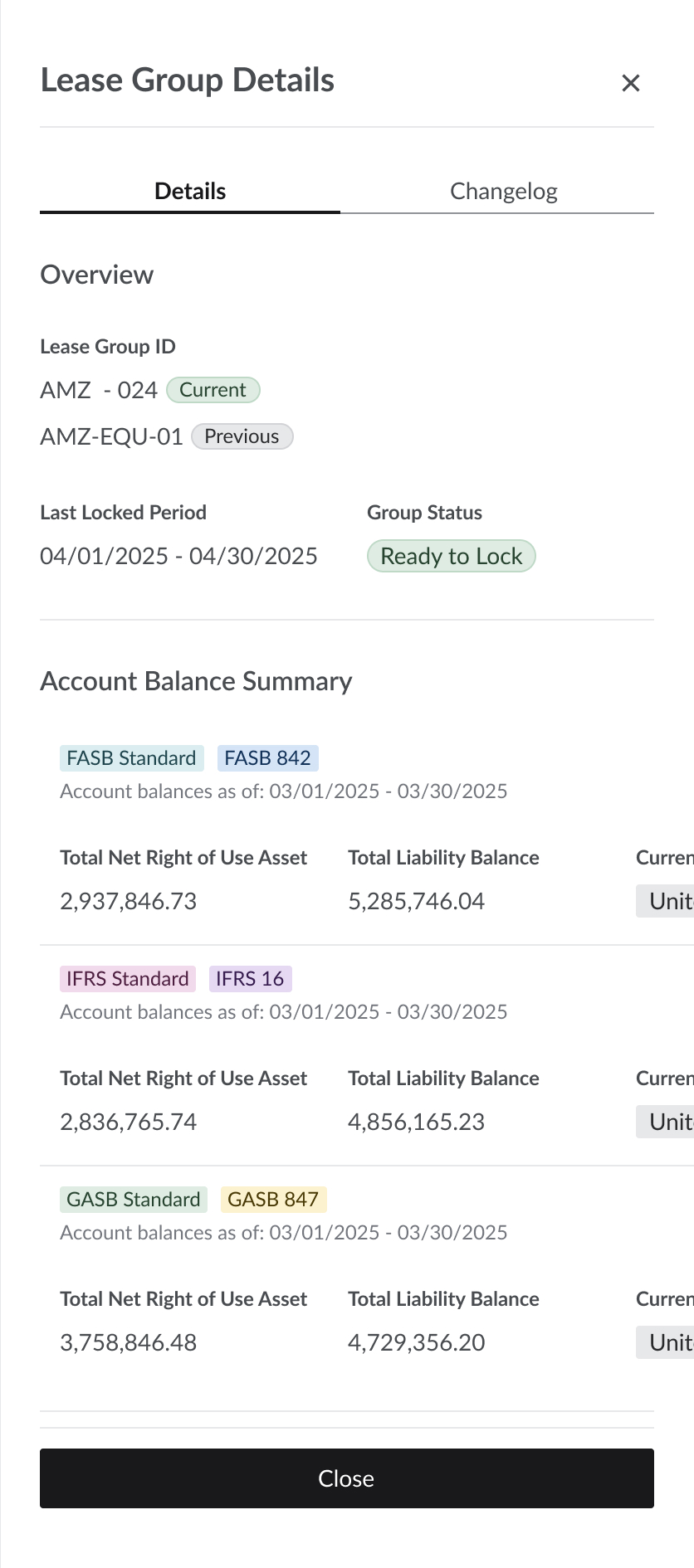
Audit Trail & Change Log
MAINTAINING TRANSPARENCY
Tracks all lock, unlock, and lease group changes across the system. Every action is recorded with user, timestamp, and action type, creating a reliable source of truth for audit review and internal compliance checks.

Process
Discovery and Research
- Stakeholder interviews
- SME insights from Accountants and Finance Admins
- Market research and analysis
- Client interviews
- Userflows
Define and Analyze
- Pain point clustering
- Identified need statements and overall themes from user interviews
Scoping with Team
- Defined MVP With Product and Dev
- Aligned on user roles and system constraints
- Prioritized based on risk and impact
Design
- Userflows
- High-fidelity prototypes
- Interaction strategy
- Experience architecture
- Systems thinking in UX
Testing & Iteration
- Usability testing
- Improved designs based on user feedback
- Handed off to Development
Final Outcome
- Beta testing
- Measure solution impact
Competitive Research
Market Analysis
To better understand how today’s systems address financial period locking, I conducted a competitive analysis of platforms including QuickBooks, SAP ByDesign, Oracle NetSuite, and Oracle Fusion ERP Cloud.
While enterprise tools offer advanced features like module-specific and granular locking, they often suffer from complex, unintuitive interfaces. On the other hand, tools like QuickBooks prioritize ease of use but lack support for complex organizational needs.
Granular Locking
User-Friendly Interface
Complex Org Support
Module-Specific Locking
Quickbooks
SAP ByDesign
Oracle NetSuite
Oracle Fusion ERP Cloud
User Flows
Exploring the period closure process through user flows.

Research & Discovery
User Interviews
Users were interviewed to better understand:
- The primary factors that contribute to why VL users’ desire to prevent the inadvertent update to financial data within their financial asset management tool at the close of a period.
- The critical functionalities and behaviors of period locking controls required for accountants to confidently and securely close reporting periods for their assets in VL.
2
Accounting Managers
To understand how they coordinate and enforce the locking process across teams.
4
Accounting Consultants
To learn how different organizations approach period locking and identify best practices.
5
Accounting Specialists
To understand how locking impacts their day-to-day close tasks.
1
Financial Controller
To learn how they ensure data integrity and control after periods are locked.
“One of my biggest frustrations with Visual Lease is that you can't lock accounting periods. If we backdate a change to a lease I have to re-run reports every time a lease is updated. If a change affects a past period, I need to manually backfill that report, check if it's already been booked, and then adjust. It’s a lot of unnecessary work.”
- Genesys
“We want to lock periods by asset class—equipment, real estate, and countries since each has different requirements and timing. Separating those helps us avoid reporting errors”
- Tenneco
"My ideal approach to locking periods would be by accounting period—not by lease or lease ID. That way I know when a period is closed, nothing else can be changed — everything else should flow into the next period.”
- RSM
"I expect future periods default to unlocked — we often get leases early and want to proactively add them. But we still want the financials to reflect the actual lease start period.”
- Kingston
Thematic Analysis
Interview transcripts were mapped to extract key insights and quotes, which were grouped into need statements to clarify the “why” behind user needs and guide design focus areas.
Supported by Senior Product Designer
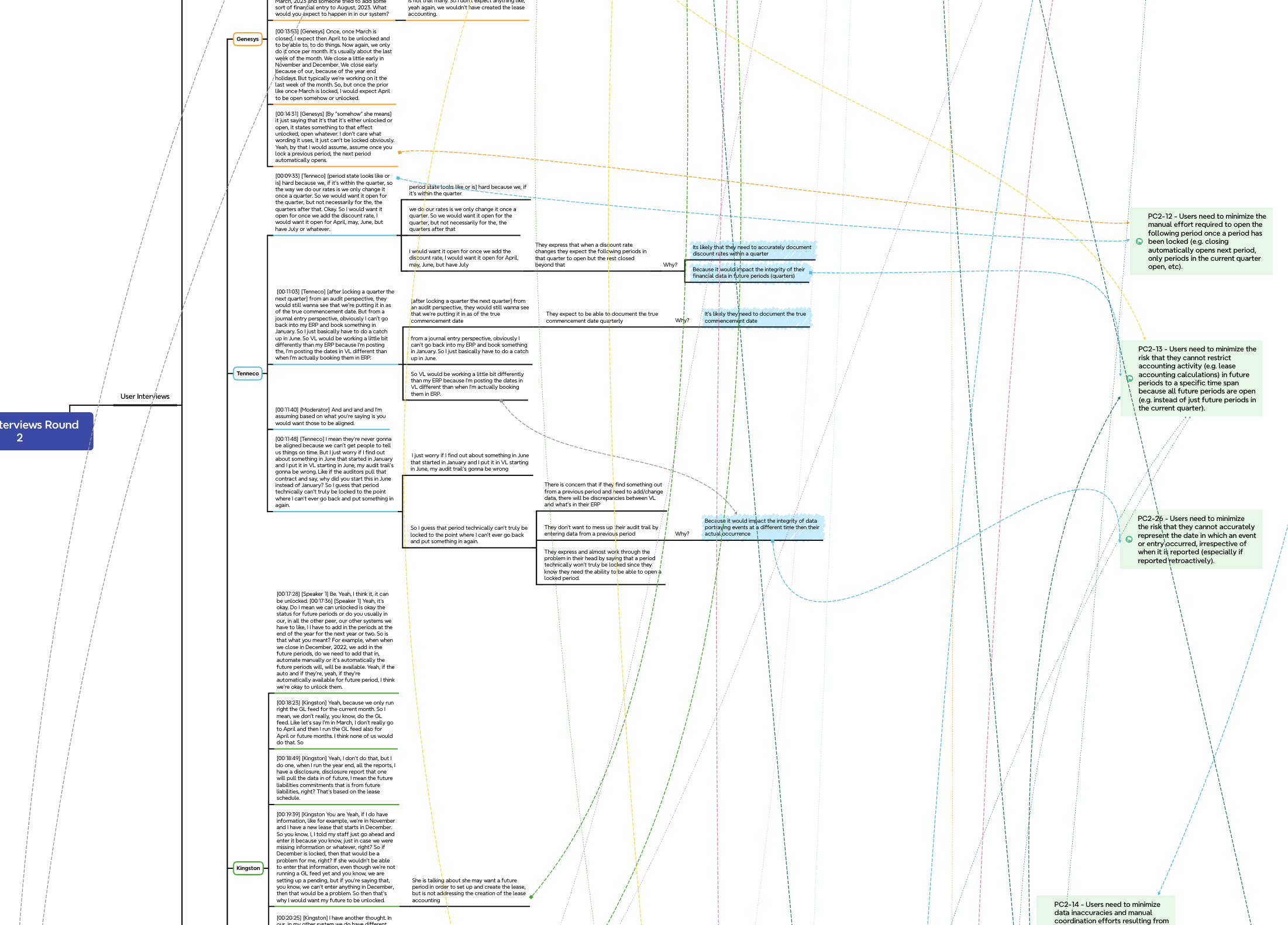
Synthesis
Thematic Analysis led to 44 unique need statements, which were then grouped into 13 overarching themes to reveal shared perspectives and experiences.
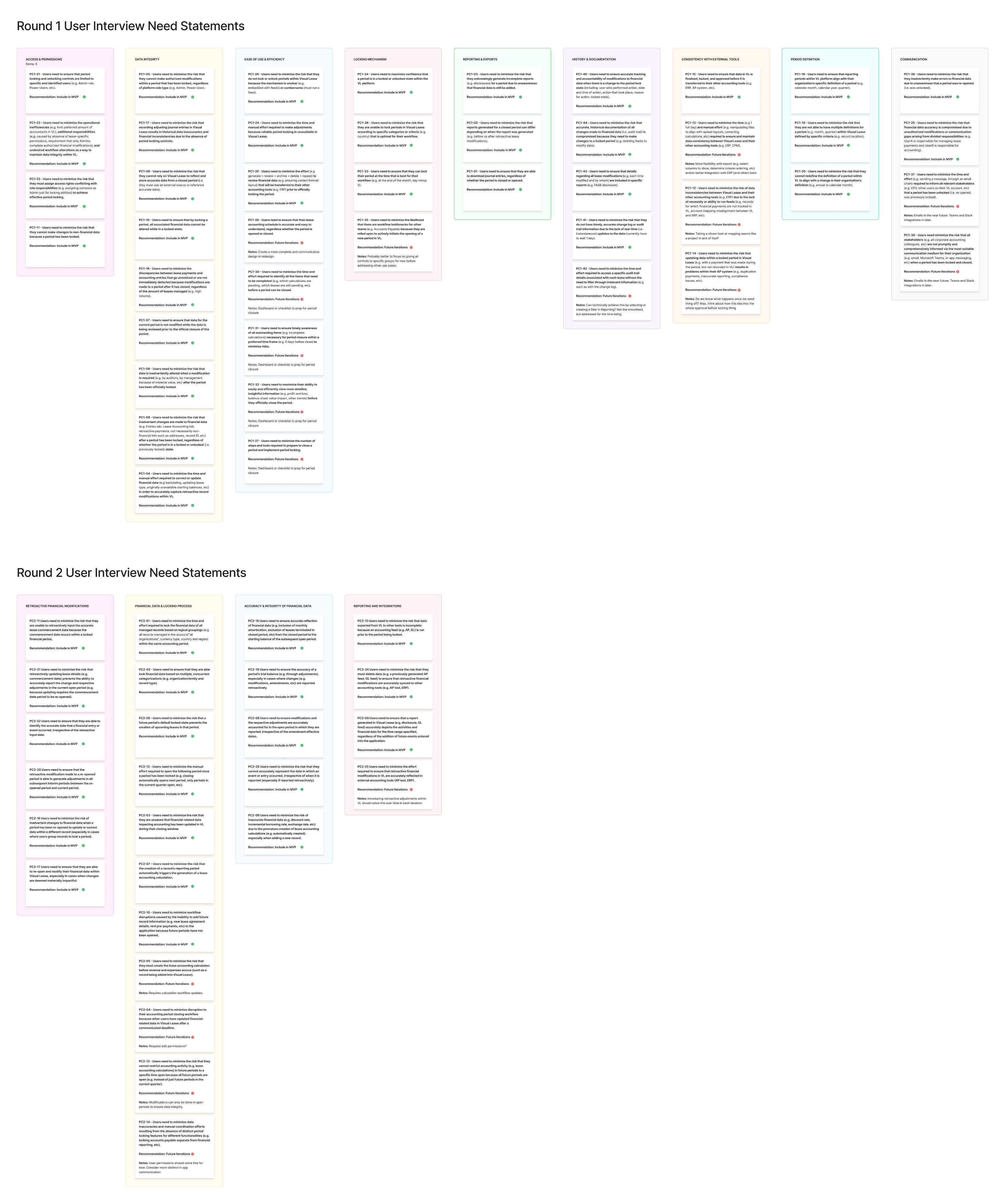
Key Themes & Insights
Access & Permissions
Not all users should be able to lock or unlock periods—controls must be limited to specific roles with admin permissions.
Data Integrity
Users need to prevent unauthorized changes to financial data before and after close, and ensure that locking protects the accuracy and completeness of records.
Ease of Use & Efficiency
Users want locking workflows that are intuitive, minimize effort, and help them confidently complete tasks with fewer steps and less confusion.
Locking Mechanism
Users need a reliable way to confirm when a period is locked and expect locking rules to match organizational or legal standards.
History & Documentation
Users need a clear audit trail showing who changed the lock state, when, and why—to support accountability and accurate reporting.
Defining Scope and MVP Challenges
Insights to Product Requirements
These decisions shaped MVP to focus on data protection, control, and auditability.
WHAT WE HEARD
Locking varies by asset class, org, and country
We need real-time visibility and logs
We don’t want people accidentally editing past data
Reformatting data for ERP is a nightmare
WHAT WE DID
Allow users to define custom locking groups
Create audit trail and locking status dashboard
Set automatic locking rules by role
Align locking export with ERP data structures
MVP Reality Check
While the initial MVP scope seemed simple, research quickly revealed it would impact multiple parts of the system. We had to map the current workflows, uncover period locking dependencies, and align across teams to understand the full scope.
This required navigating new product development processes while advocating for users. I partnered closely with product and engineering to ensure we didn’t compromise on data integrity, usability, or user needs in favor of speed.
One key discussion was around grouping records by asset class. Though the system already supported a similar concept called Saved Filters, it wasn’t clear if this pattern could meet the new need—so we brought it into usability testing to evaluate its viability.
Mapping the Current System
Mapping the current system helped us identify which parts of the platform would be affected by a locked or unlocked period. This gave us clarity on scope and allowed us to make informed decisions around in-app messaging and user awareness.
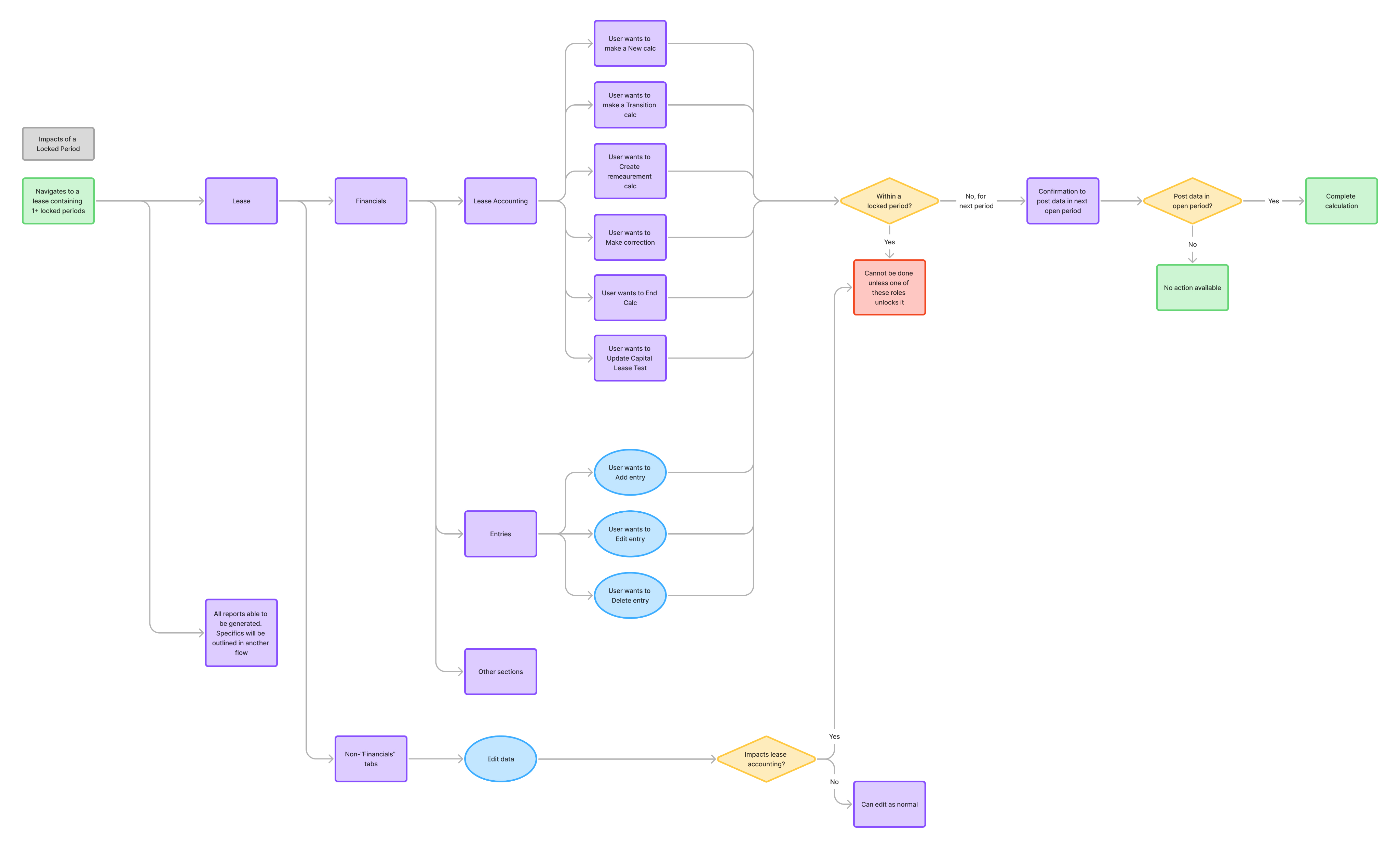
User Testing & Iteration
Usability Testing
After feedback from the UX team and stakeholders, I ran usability testing to evaluate potential issues and validate if the existing grouping method could support bulk period management. Users from initial discovery interviews were given scenarios to create lease groups using both the new asset grouping approach and saved filters, then asked to lock and unlock periods.
Testing was done with the old design system, but the feature launched using the new Paper design system.
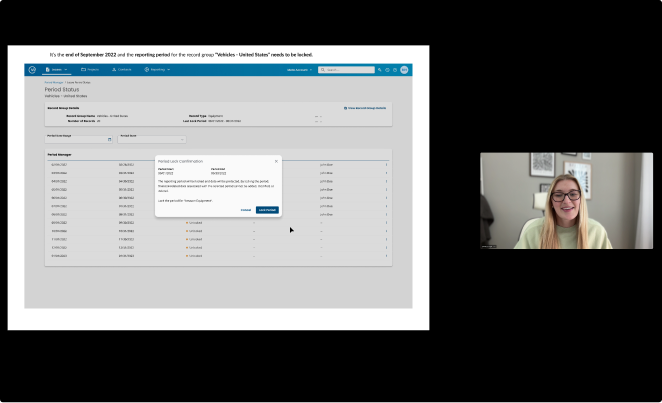
Testing Insights
Saved Filters vs Lease Groups
While saved filters resemble how they'd group for period locking, they’d need to adjust configurations and don’t want to edit existing filters.
Filters Used as Security Workarounds
Users rely on saved filters to limit access, using them as a workaround for missing permission controls in the system.
Flexible Grouping Needs
Users need to group records by attributes like organization, country, record type, and classification to match how they manage periods.
Consistency Between Locking and Reporting
Users expect lease groups used for period locking to match those used in reports for alignment and accuracy.
Effective Feedback for Locking Actions
Clear in-app feedback for lock/unlock actions worked well—users found it helpful, and usability issues were minimal.
Takeaways
Saved filters aren't a one-size-fits-all solution
Users need a more purpose-built grouping mechanism for period locking that doesn’t disrupt their existing workflows or access controls.
Permissions and visibility matter
Relying on filters for access control surfaced deeper needs around security and role-based visibility.
Grouping logic needs to be flexible and consistent
Grouping by organization, country, record type, and classification must be supported—and align with how users generate reports.
The locking experience is on the right track
Feedback during locking/unlocking was clear and well-received, giving us confidence in the current interaction model.
Project Outcomes
38%
Improvement in Data Accuracy
31%
Reduction in Manual Locking Efforts
32%
Increase in User Satisfaction Ratings
Reflection
Designing for complexity takes time
Even a “simple” feature like period locking can reveal deep system dependencies and require input across multiple roles.
User advocacy is a constant
Balancing speed with usability and data integrity required continuous collaboration and compromise with product and engineering.
Patterns don’t always scale
Relying on existing UI concepts (like saved filters) challenged assumptions about reusability and forced us to re-evaluate what’s “good enough” vs. purpose-built.
Testing early built confidence
Usability testing surfaced key gaps early and helped validate the locking flow, saving time down the line.
Next Steps
Define a long-term grouping model
Explore creating dedicated grouping functionality for period management that coexists with saved filters.
Strengthen permission controls
Users need more controls to assign users month end close tasks.
Align locking and reporting
Work with reporting stakeholders to ensure group definitions can be shared or mirrored across features.
Continue testing with edge cases
Expand usability testing to include more complex org setups (e.g., multi-country, multi-entity) to stress-test the grouping logic.
Work
Resume
Financial Close Manager
A solution for Accountants to securely and confidently lock financial data.


Objective
Understand users needs around period locking controls and create a solution that preserves historical financial data for accurate reporting and reconciliation.
My Role
Discovery Research
Ideation
Product Design
Testing and Validation
Post Launch Activities
Cross Collaboration
Product Design
Product
Engineering
Tools
Figma
Figjam
Microsoft Word
EnjoyHQ
Xminds
Teams
The Challenge
Today, Visual Lease users can change financial data at any time due to a lack of accounting controls that ensure data integrity. This introduces compliance risk and complicates audit readiness. Users need a reliable way to lock historical data and control what can be changed.
Customer Requests
47% of customers submitted support requests or feedback specifically asking for a period locking feature.
Changes Before Locking Periods
On average, users made 12+ changes per quarter to historical periods, increasing risk of audit discrepancies.
Audit and Compliance Impact
According to Deloitte, lack of locking controls is one of the top 3 reasons for failed audits in accounting firms.
Period Locking Adoption in Accounting Software
95% of leading ERP systems include period locking as a core feature to preserve data integrity.
The Solution


The Financial Close Manager is centralized period locking solution for accountants. It streamlines the period closing process by securing financial data, ensuring audit readiness, and supporting accurate reporting by letting users lock historical periods.
Key Features
Secure Locking Controls
PROTECTING DATA ACCURACY
Periods can be locked to prevent edits to financial data once reviewed and approved. Only authorized users can apply locks, and multiple periods can be locked at once for efficiency. This ensures users can't make changes to finalized data, reducing the risk of errors or rework.


Controlled Lease Groups
MANAGING LEASES WITH PRECISION
Leases are grouped into customizable sets based on business rules or reporting structure. This enables users to lock and manage periods for specific lease groups without affecting others, supporting more flexible and targeted close workflows.
Account Balance
VERIFYING FINANCIAL ALIGNMENT
Displays key account balances at period close, helping users confirm totals match their ERP system. When balances align, users gain confidence to proceed with closing without the need to unlock or revise later — minimizing disruption and ensuring a smoother process.


Audit Trail & Change Log
MAINTAINING TRANSPARENCY
Tracks all lock, unlock, and lease group changes across the system. Every action is recorded with user, timestamp, and action type, creating a reliable source of truth for audit review and internal compliance checks.
Process
Discovery and Research
- Stakeholder interviews
- SME insights from Accountants and Finance Admins
- Market research and analysis
- Client interviews
- Userflows
Scoping with Team
- Defined MVP With Product and Dev
- Aligned on user roles and system constraints
- Prioritized based on risk and impact
Testing & Iteration
- Usability testing
- Improved designs based on user feedback
- Handed off to Development
Define and Analyze
- Pain point clustering
- Identified need statements and overall themes from user interviews
Design
- Userflows
- High-fidelity prototypes
- Interaction strategy
- Experience architecture
- Systems thinking in UX
Final Outcome
- Beta testing
- Measure solution impact
Competitive Research
Market Analysis
To better understand how today’s systems address financial period locking, I conducted a competitive analysis of platforms including QuickBooks, SAP ByDesign, Oracle NetSuite, and Oracle Fusion ERP Cloud.
While enterprise tools offer advanced features like module-specific and granular locking, they often suffer from complex, unintuitive interfaces. On the other hand, tools like QuickBooks prioritize ease of use but lack support for complex organizational needs.
Granular Locking
User-Friendly Interface
Complex Org Support
Module-Specific Locking
Quickbooks
SAP ByDesign
Oracle NetSuite
Oracle Fusion ERP Cloud
User Flows
Exploring the period closure process through user flows.

Research & Discovery
User Interviews
Users were interviewed to better understand:
- The primary factors that contribute to why VL users’ desire to prevent the inadvertent update to financial data within their financial asset management tool at the close of a period.
- The critical functionalities and behaviors of period locking controls required for accountants to confidently and securely close reporting periods for their assets in VL.
2
Accounting Managers
To understand how they coordinate and enforce the locking process across teams.
4
Accounting Consultants
To learn how different organizations approach period locking and identify best practices.
5
Accounting Specialists
To understand how locking impacts their day-to-day close tasks.
1
Financial Controller
To learn how they ensure data integrity and control after periods are locked.
“One of my biggest frustrations with Visual Lease is that you can't lock accounting periods. If we backdate a change to a lease I have to re-run reports every time a lease is updated. If a change affects a past period, I need to manually backfill that report, check if it's already been booked, and then adjust. It’s a lot of unnecessary work.”
- Genesys
“We want to lock periods by asset class—equipment, real estate, and countries since each has different requirements and timing. Separating those helps us avoid reporting errors”
- Tenneco
"My ideal approach to locking periods would be by accounting period—not by lease or lease ID. That way I know when a period is closed, nothing else can be changed — everything else should flow into the next period.”
- RSM
"I expect future periods default to unlocked — we often get leases early and want to proactively add them. But we still want the financials to reflect the actual lease start period.”
- Kingston
Thematic Analysis
Interview transcripts were mapped to extract key insights and quotes, which were grouped into need statements to clarify the “why” behind user needs and guide design focus areas.
Supported by Senior Product Designer

Synthesis
Thematic Analysis led to 44 unique need statements, which were then grouped into 13 overarching themes to reveal shared perspectives and experiences.

Key Themes & Insights
Access & Permissions
Not all users should be able to lock or unlock periods—controls must be limited to specific roles with admin permissions.
Data Integrity
Users need to prevent unauthorized changes to financial data before and after close, and ensure that locking protects the accuracy and completeness of records.
Ease of Use & Efficiency
Users want locking workflows that are intuitive, minimize effort, and help them confidently complete tasks with fewer steps and less confusion.
Locking Mechanism
Users need a reliable way to confirm when a period is locked and expect locking rules to match organizational or legal standards.
History & Documentation
Users need a clear audit trail showing who changed the lock state, when, and why—to support accountability and accurate reporting.
Defining Scope and MVP Challenges
Insights to Product Requirements
These decisions shaped MVP to focus on data protection, control, and auditability.
WHAT WE HEARD
Locking varies by asset class, org, and country
We need real-time visibility and logs
We don’t want people accidentally editing past data
Reformatting data for ERP is a nightmare
WHAT WE DID
Allow users to define custom locking groups
Create audit trail and locking status dashboard
Set automatic locking rules by role
Align locking export with ERP data structures
MVP Reality Check
While the initial MVP scope seemed simple, research quickly revealed it would impact multiple parts of the system. We had to map the current workflows, uncover period locking dependencies, and align across teams to understand the full scope.
This required navigating new product development processes while advocating for users. I partnered closely with product and engineering to ensure we didn’t compromise on data integrity, usability, or user needs in favor of speed.
One key discussion was around grouping records by asset class. Though the system already supported a similar concept called Saved Filters, it wasn’t clear if this pattern could meet the new need—so we brought it into usability testing to evaluate its viability.
Mapping the Current System
Mapping the current system helped us identify which parts of the platform would be affected by a locked or unlocked period. This gave us clarity on scope and allowed us to make informed decisions around in-app messaging and user awareness.

User Testing & Iteration
Usability Testing
After feedback from the UX team and stakeholders, I ran usability testing to evaluate potential issues and validate if the existing grouping method could support bulk period management. Users from initial discovery interviews were given scenarios to create lease groups using both the new asset grouping approach and saved filters, then asked to lock and unlock periods.
Testing was done with the old design system, but the feature launched using the new Paper design system.
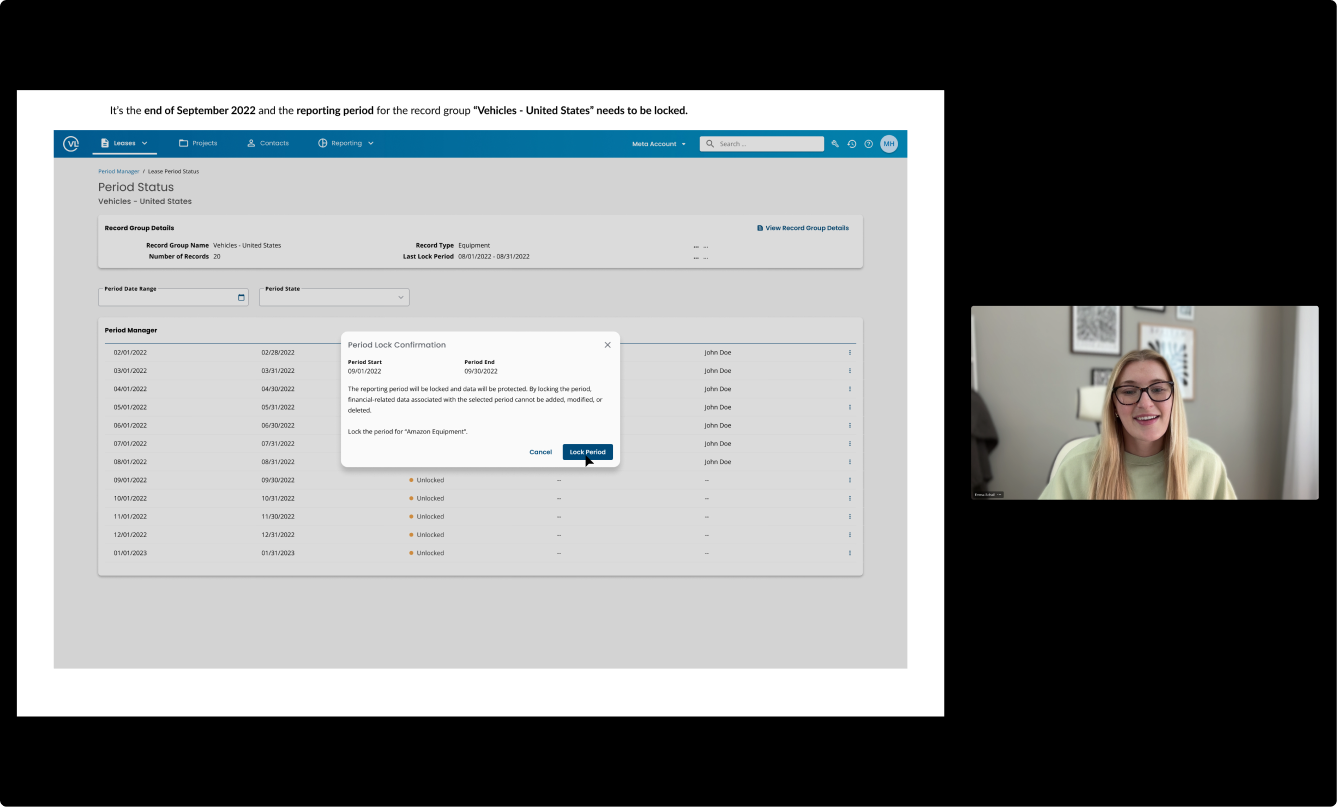
Testing Insights
Saved Filters vs Lease Groups
While saved filters resemble how they'd group for period locking, they’d need to adjust configurations and don’t want to edit existing filters.
Filters Used as Security Workarounds
Users rely on saved filters to limit access, using them as a workaround for missing permission controls in the system.
Flexible Grouping Needs
Users need to group records by attributes like organization, country, record type, and classification to match how they manage periods.
Consistency Between Locking and Reporting
Users expect lease groups used for period locking to match those used in reports for alignment and accuracy.
Effective Feedback for Locking Actions
Clear in-app feedback for lock/unlock actions worked well—users found it helpful, and usability issues were minimal.
Takeaways
Saved filters aren't a one-size-fits-all solution
Users need a more purpose-built grouping mechanism for period locking that doesn’t disrupt their existing workflows or access controls.
Permissions and visibility matter
Relying on filters for access control surfaced deeper needs around security and role-based visibility.
Grouping logic needs to be flexible and consistent
Grouping by organization, country, record type, and classification must be supported—and align with how users generate reports.
The locking experience is on the right track
Feedback during locking/unlocking was clear and well-received, giving us confidence in the current interaction model.
Project Outcomes
38%
Improvement in Data Accuracy
31%
Reduction in Manual Locking Efforts
32%
Increase in User Satisfaction Ratings
Reflection
Designing for complexity takes time
Even a “simple” feature like period locking can reveal deep system dependencies and require input across multiple roles.
User advocacy is a constant
Balancing speed with usability and data integrity required continuous collaboration and compromise with product and engineering.
Patterns don’t always scale
Relying on existing UI concepts (like saved filters) challenged assumptions about reusability and forced us to re-evaluate what’s “good enough” vs. purpose-built.
Testing early built confidence
Usability testing surfaced key gaps early and helped validate the locking flow, saving time down the line.
Next Steps
Define a long-term grouping model
Explore creating dedicated grouping functionality for period management that coexists with saved filters.
Strengthen permission controls
Users need more controls to assign users month end close tasks.
Align locking and reporting
Work with reporting stakeholders to ensure group definitions can be shared or mirrored across features.
Continue testing with edge cases
Expand usability testing to include more complex org setups (e.g., multi-country, multi-entity) to stress-test the grouping logic.
Work
Resume
Financial Close Manager
A solution for Accountants to securely and confidently lock financial data.


Objective
Understand users needs around period locking controls and create a solution that preserves historical financial data for accurate reporting and reconciliation.
My Role
Discovery Research
Ideation
Product Design
Testing and Validation
Post Launch Activities
Cross Collaboration
Product Design
Product
Engineering
Tools
Figma
Figjam
Microsoft Word
EnjoyHQ
Xminds
Teams
The Challenge
Today, Visual Lease users can change financial data at any time due to a lack of accounting controls that ensure data integrity. This introduces compliance risk and complicates audit readiness. Users need a reliable way to lock historical data and control what can be changed.
Customer Requests
47% of customers submitted support requests or feedback specifically asking for a period locking feature.
Changes Before Locking Periods
On average, users made 12+ changes per quarter to historical periods, increasing risk of audit discrepancies.
Audit and Compliance Impact
According to Deloitte, lack of locking controls is one of the top 3 reasons for failed audits in accounting firms.
Period Locking Adoption in Accounting Software
95% of leading ERP systems include period locking as a core feature to preserve data integrity.
The Solution


The Financial Close Manager is centralized period locking solution for accountants. It streamlines the period closing process by securing financial data, ensuring audit readiness, and supporting accurate reporting by letting users lock historical periods.
Key Features
Secure Locking Controls
PROTECTING DATA ACCURACY
Periods can be locked to prevent edits to financial data once reviewed and approved. Only authorized users can apply locks, and multiple periods can be locked at once for efficiency. This ensures users can't make changes to finalized data, reducing the risk of errors or rework.


Controlled Lease Groups
MANAGING LEASES WITH PRECISION
Leases are grouped into customizable sets based on business rules or reporting structure. This enables users to lock and manage periods for specific lease groups without affecting others, supporting more flexible and targeted close workflows.
Account Balance
VERIFYING FINANCIAL ALIGNMENT
Displays key account balances at period close, helping users confirm totals match their ERP system. When balances align, users gain confidence to proceed with closing without the need to unlock or revise later — minimizing disruption and ensuring a smoother process.


Audit Trail & Change Log
MAINTAINING TRANSPARENCY
Tracks all lock, unlock, and lease group changes across the system. Every action is recorded with user, timestamp, and action type, creating a reliable source of truth for audit review and internal compliance checks.
Process
Discovery and Research
- Stakeholder interviews
- SME insights from Accountants and Finance Admins
- Market research and analysis
- Client interviews
- Userflows
Scoping with Team
- Defined MVP With Product and Dev
- Aligned on user roles and system constraints
- Prioritized based on risk and impact
Testing & Iteration
- Usability testing
- Improved designs based on user feedback
- Handed off to Development
Define and Analyze
- Pain point clustering
- Identified need statements and overall themes from user interviews
Design
- Userflows
- High-fidelity prototypes
- Interaction strategy
- Experience architecture
- Systems thinking in UX
Final Outcome
- Beta testing
- Measure solution impact
Competitive Research
Market Analysis
To better understand how today’s systems address financial period locking, I conducted a competitive analysis of platforms including QuickBooks, SAP ByDesign, Oracle NetSuite, and Oracle Fusion ERP Cloud.
While enterprise tools offer advanced features like module-specific and granular locking, they often suffer from complex, unintuitive interfaces. On the other hand, tools like QuickBooks prioritize ease of use but lack support for complex organizational needs.
Granular Locking
User-Friendly Interface
Complex Org Support
Module-Specific Locking
Quickbooks
SAP ByDesign
Oracle NetSuite
Oracle Fusion ERP Cloud
User Flows
Exploring the period closure process through user flows.

Research & Discovery
User Interviews
Users were interviewed to better understand:
- The primary factors that contribute to why VL users’ desire to prevent the inadvertent update to financial data within their financial asset management tool at the close of a period.
- The critical functionalities and behaviors of period locking controls required for accountants to confidently and securely close reporting periods for their assets in VL.
2
Accounting Managers
To understand how they coordinate and enforce the locking process across teams.
4
Accounting Consultants
To learn how different organizations approach period locking and identify best practices.
5
Accounting Specialists
To understand how locking impacts their day-to-day close tasks.
1
Financial Controller
To learn how they ensure data integrity and control after periods are locked.
“One of my biggest frustrations with Visual Lease is that you can't lock accounting periods. If we backdate a change to a lease I have to re-run reports every time a lease is updated. If a change affects a past period, I need to manually backfill that report, check if it's already been booked, and then adjust. It’s a lot of unnecessary work.”
- Genesys
“We want to lock periods by asset class—equipment, real estate, and countries since each has different requirements and timing. Separating those helps us avoid reporting errors”
- Tenneco
"My ideal approach to locking periods would be by accounting period—not by lease or lease ID. That way I know when a period is closed, nothing else can be changed — everything else should flow into the next period.”
- RSM
"I expect future periods default to unlocked — we often get leases early and want to proactively add them. But we still want the financials to reflect the actual lease start period.”
- Kingston
Thematic Analysis
Interview transcripts were mapped to extract key insights and quotes, which were grouped into need statements to clarify the “why” behind user needs and guide design focus areas.
Supported by Senior Product Designer

Synthesis
Thematic Analysis led to 44 unique need statements, which were then grouped into 13 overarching themes to reveal shared perspectives and experiences.

Key Themes & Insights
Access & Permissions
Not all users should be able to lock or unlock periods—controls must be limited to specific roles with admin permissions.
Data Integrity
Users need to prevent unauthorized changes to financial data before and after close, and ensure that locking protects the accuracy and completeness of records.
Ease of Use & Efficiency
Users want locking workflows that are intuitive, minimize effort, and help them confidently complete tasks with fewer steps and less confusion.
Locking Mechanism
Users need a reliable way to confirm when a period is locked and expect locking rules to match organizational or legal standards.
History & Documentation
Users need a clear audit trail showing who changed the lock state, when, and why—to support accountability and accurate reporting.
Defining Scope and MVP Challenges
Insights to Product Requirements
These decisions shaped MVP to focus on data protection, control, and auditability.
WHAT WE HEARD
Locking varies by asset class, org, and country
We need real-time visibility and logs
We don’t want people accidentally editing past data
Reformatting data for ERP is a nightmare
WHAT WE DID
Allow users to define custom locking groups
Create audit trail and locking status dashboard
Set automatic locking rules by role
Align locking export with ERP data structures
MVP Reality Check
While the initial MVP scope seemed simple, research quickly revealed it would impact multiple parts of the system. We had to map the current workflows, uncover period locking dependencies, and align across teams to understand the full scope.
This required navigating new product development processes while advocating for users. I partnered closely with product and engineering to ensure we didn’t compromise on data integrity, usability, or user needs in favor of speed.
One key discussion was around grouping records by asset class. Though the system already supported a similar concept called Saved Filters, it wasn’t clear if this pattern could meet the new need—so we brought it into usability testing to evaluate its viability.
Mapping the Current System
Mapping the current system helped us identify which parts of the platform would be affected by a locked or unlocked period. This gave us clarity on scope and allowed us to make informed decisions around in-app messaging and user awareness.

User Testing & Iteration
Usability Testing
After feedback from the UX team and stakeholders, I ran usability testing to evaluate potential issues and validate if the existing grouping method could support bulk period management. Users from initial discovery interviews were given scenarios to create lease groups using both the new asset grouping approach and saved filters, then asked to lock and unlock periods.
Testing was done with the old design system, but the feature launched using the new Paper design system.
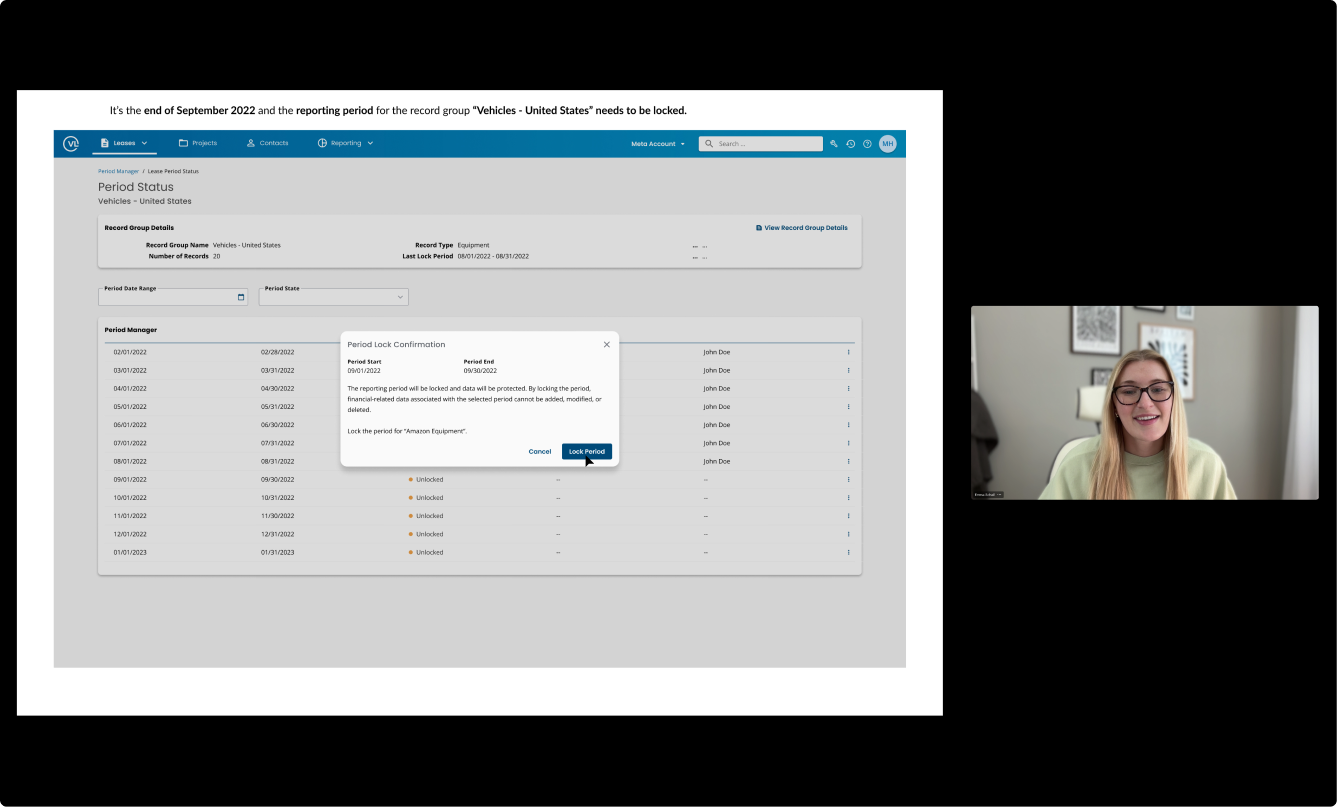
Testing Insights
Saved Filters vs Lease Groups
While saved filters resemble how they'd group for period locking, they’d need to adjust configurations and don’t want to edit existing filters.
Filters Used as Security Workarounds
Users rely on saved filters to limit access, using them as a workaround for missing permission controls in the system.
Flexible Grouping Needs
Users need to group records by attributes like organization, country, record type, and classification to match how they manage periods.
Consistency Between Locking and Reporting
Users expect lease groups used for period locking to match those used in reports for alignment and accuracy.
Effective Feedback for Locking Actions
Clear in-app feedback for lock/unlock actions worked well—users found it helpful, and usability issues were minimal.
Takeaways
Saved filters aren't a one-size-fits-all solution
Users need a more purpose-built grouping mechanism for period locking that doesn’t disrupt their existing workflows or access controls.
Permissions and visibility matter
Relying on filters for access control surfaced deeper needs around security and role-based visibility.
Grouping logic needs to be flexible and consistent
Grouping by organization, country, record type, and classification must be supported—and align with how users generate reports.
The locking experience is on the right track
Feedback during locking/unlocking was clear and well-received, giving us confidence in the current interaction model.
Project Outcomes
38%
Improvement in Data Accuracy
31%
Reduction in Manual Locking Efforts
32%
Increase in User Satisfaction Ratings
Reflection
Designing for complexity takes time
Even a “simple” feature like period locking can reveal deep system dependencies and require input across multiple roles.
User advocacy is a constant
Balancing speed with usability and data integrity required continuous collaboration and compromise with product and engineering.
Patterns don’t always scale
Relying on existing UI concepts (like saved filters) challenged assumptions about reusability and forced us to re-evaluate what’s “good enough” vs. purpose-built.
Testing early built confidence
Usability testing surfaced key gaps early and helped validate the locking flow, saving time down the line.
Next Steps
Define a long-term grouping model
Explore creating dedicated grouping functionality for period management that coexists with saved filters.
Strengthen permission controls
Users need more controls to assign users month end close tasks.
Align locking and reporting
Work with reporting stakeholders to ensure group definitions can be shared or mirrored across features.
Continue testing with edge cases
Expand usability testing to include more complex org setups (e.g., multi-country, multi-entity) to stress-test the grouping logic.
Work
Resume
Financial Close Manager
A solution for Accountants to securely and confidently lock financial data.


Objective
Understand users needs around period locking controls and create a solution that preserves historical financial data for accurate reporting and reconciliation.
My Role
Discovery Research
Ideation
Product Design
Testing and Validation
Post Launch Activities
Cross Collaboration
Product Design
Product
Engineering
Tools
Figma
Figjam
Microsoft Word
EnjoyHQ
Xminds
Teams
The Challenge
Today, Visual Lease users can change financial data at any time due to a lack of accounting controls that ensure data integrity. This introduces compliance risk and complicates audit readiness. Users need a reliable way to lock historical data and control what can be changed.
Customer Requests
47% of customers submitted support requests or feedback specifically asking for a period locking feature.
Changes Before Locking Periods
On average, users made 12+ changes per quarter to historical periods, increasing risk of audit discrepancies.
Audit and Compliance Impact
According to Deloitte, lack of locking controls is one of the top 3 reasons for failed audits in accounting firms.
Period Locking Adoption in Accounting Software
95% of leading ERP systems include period locking as a core feature to preserve data integrity.
The Solution


The Financial Close Manager is centralized period locking solution for accountants. It streamlines the period closing process by securing financial data, ensuring audit readiness, and supporting accurate reporting by letting users lock historical periods.
Key Features
Secure Locking Controls
PROTECTING DATA ACCURACY
Periods can be locked to prevent edits to financial data once reviewed and approved. Only authorized users can apply locks, and multiple periods can be locked at once for efficiency. This ensures users can't make changes to finalized data, reducing the risk of errors or rework.


Controlled Lease Groups
MANAGING LEASES WITH PRECISION
Leases are grouped into customizable sets based on business rules or reporting structure. This enables users to lock and manage periods for specific lease groups without affecting others, supporting more flexible and targeted close workflows.
Account Balance
VERIFYING FINANCIAL ALIGNMENT
Displays key account balances at period close, helping users confirm totals match their ERP system. When balances align, users gain confidence to proceed with closing without the need to unlock or revise later — minimizing disruption and ensuring a smoother process.


Audit Trail & Change Log
MAINTAINING TRANSPARENCY
Tracks all lock, unlock, and lease group changes across the system. Every action is recorded with user, timestamp, and action type, creating a reliable source of truth for audit review and internal compliance checks.
Process
Discovery and Research
- Stakeholder interviews
- SME insights from Accountants and Finance Admins
- Market research and analysis
- Client interviews
- Userflows
Scoping with Team
- Defined MVP With Product and Dev
- Aligned on user roles and system constraints
- Prioritized based on risk and impact
Testing & Iteration
- Usability testing
- Improved designs based on user feedback
- Handed off to Development
Define and Analyze
- Pain point clustering
- Identified need statements and overall themes from user interviews
Design
- Userflows
- High-fidelity prototypes
- Interaction strategy
- Experience architecture
- Systems thinking in UX
Final Outcome
- Beta testing
- Measure solution impact
Competitive Research
Market Analysis
To better understand how today’s systems address financial period locking, I conducted a competitive analysis of platforms including QuickBooks, SAP ByDesign, Oracle NetSuite, and Oracle Fusion ERP Cloud.
While enterprise tools offer advanced features like module-specific and granular locking, they often suffer from complex, unintuitive interfaces. On the other hand, tools like QuickBooks prioritize ease of use but lack support for complex organizational needs.
Granular Locking
User-Friendly Interface
Complex Org Support
Module-Specific Locking
Quickbooks
SAP ByDesign
Oracle NetSuite
Oracle Fusion ERP Cloud
User Flows
Exploring the period closure process through user flows.

Research & Discovery
User Interviews
Users were interviewed to better understand:
- The primary factors that contribute to why VL users’ desire to prevent the inadvertent update to financial data within their financial asset management tool at the close of a period.
- The critical functionalities and behaviors of period locking controls required for accountants to confidently and securely close reporting periods for their assets in VL.
2
Accounting Managers
To understand how they coordinate and enforce the locking process across teams.
4
Accounting Consultants
To learn how different organizations approach period locking and identify best practices.
5
Accounting Specialists
To understand how locking impacts their day-to-day close tasks.
1
Financial Controller
To learn how they ensure data integrity and control after periods are locked.
“One of my biggest frustrations with Visual Lease is that you can't lock accounting periods. If we backdate a change to a lease I have to re-run reports every time a lease is updated. If a change affects a past period, I need to manually backfill that report, check if it's already been booked, and then adjust. It’s a lot of unnecessary work.”
- Genesys
“We want to lock periods by asset class—equipment, real estate, and countries since each has different requirements and timing. Separating those helps us avoid reporting errors”
- Tenneco
"My ideal approach to locking periods would be by accounting period—not by lease or lease ID. That way I know when a period is closed, nothing else can be changed — everything else should flow into the next period.”
- RSM
"I expect future periods default to unlocked — we often get leases early and want to proactively add them. But we still want the financials to reflect the actual lease start period.”
- Kingston
Thematic Analysis
Interview transcripts were mapped to extract key insights and quotes, which were grouped into need statements to clarify the “why” behind user needs and guide design focus areas.
Supported by Senior Product Designer

Synthesis
Thematic Analysis led to 44 unique need statements, which were then grouped into 13 overarching themes to reveal shared perspectives and experiences.

Key Themes & Insights
Access & Permissions
Not all users should be able to lock or unlock periods—controls must be limited to specific roles with admin permissions.
Data Integrity
Users need to prevent unauthorized changes to financial data before and after close, and ensure that locking protects the accuracy and completeness of records.
Ease of Use & Efficiency
Users want locking workflows that are intuitive, minimize effort, and help them confidently complete tasks with fewer steps and less confusion.
Locking Mechanism
Users need a reliable way to confirm when a period is locked and expect locking rules to match organizational or legal standards.
History & Documentation
Users need a clear audit trail showing who changed the lock state, when, and why—to support accountability and accurate reporting.
Defining Scope and MVP Challenges
Insights to Product Requirements
These decisions shaped MVP to focus on data protection, control, and auditability.
WHAT WE HEARD
Locking varies by asset class, org, and country
We need real-time visibility and logs
We don’t want people accidentally editing past data
Reformatting data for ERP is a nightmare
WHAT WE DID
Allow users to define custom locking groups
Create audit trail and locking status dashboard
Set automatic locking rules by role
Align locking export with ERP data structures
MVP Reality Check
While the initial MVP scope seemed simple, research quickly revealed it would impact multiple parts of the system. We had to map the current workflows, uncover period locking dependencies, and align across teams to understand the full scope.
This required navigating new product development processes while advocating for users. I partnered closely with product and engineering to ensure we didn’t compromise on data integrity, usability, or user needs in favor of speed.
One key discussion was around grouping records by asset class. Though the system already supported a similar concept called Saved Filters, it wasn’t clear if this pattern could meet the new need—so we brought it into usability testing to evaluate its viability.
Mapping the Current System
Mapping the current system helped us identify which parts of the platform would be affected by a locked or unlocked period. This gave us clarity on scope and allowed us to make informed decisions around in-app messaging and user awareness.

User Testing & Iteration
Usability Testing
After feedback from the UX team and stakeholders, I ran usability testing to evaluate potential issues and validate if the existing grouping method could support bulk period management. Users from initial discovery interviews were given scenarios to create lease groups using both the new asset grouping approach and saved filters, then asked to lock and unlock periods.
Testing was done with the old design system, but the feature launched using the new Paper design system.

Testing Insights
Saved Filters vs Lease Groups
While saved filters resemble how they'd group for period locking, they’d need to adjust configurations and don’t want to edit existing filters.
Filters Used as Security Workarounds
Users rely on saved filters to limit access, using them as a workaround for missing permission controls in the system.
Flexible Grouping Needs
Users need to group records by attributes like organization, country, record type, and classification to match how they manage periods.
Consistency Between Locking and Reporting
Users expect lease groups used for period locking to match those used in reports for alignment and accuracy.
Effective Feedback for Locking Actions
Clear in-app feedback for lock/unlock actions worked well—users found it helpful, and usability issues were minimal.
Takeaways
Saved filters aren't a one-size-fits-all solution
Users need a more purpose-built grouping mechanism for period locking that doesn’t disrupt their existing workflows or access controls.
Permissions and visibility matter
Relying on filters for access control surfaced deeper needs around security and role-based visibility.
Grouping logic needs to be flexible and consistent
Grouping by organization, country, record type, and classification must be supported—and align with how users generate reports.
The locking experience is on the right track
Feedback during locking/unlocking was clear and well-received, giving us confidence in the current interaction model.
Project Outcomes
38%
Improvement in Data Accuracy
31%
Reduction in Manual Locking Efforts
32%
Increase in User Satisfaction Ratings
Reflection
Designing for complexity takes time
Even a “simple” feature like period locking can reveal deep system dependencies and require input across multiple roles.
User advocacy is a constant
Balancing speed with usability and data integrity required continuous collaboration and compromise with product and engineering.
Patterns don’t always scale
Relying on existing UI concepts (like saved filters) challenged assumptions about reusability and forced us to re-evaluate what’s “good enough” vs. purpose-built.
Testing early built confidence
Usability testing surfaced key gaps early and helped validate the locking flow, saving time down the line.
Next Steps
Define a long-term grouping model
Explore creating dedicated grouping functionality for period management that coexists with saved filters.
Strengthen permission controls
Users need more controls to assign users month end close tasks.
Align locking and reporting
Work with reporting stakeholders to ensure group definitions can be shared or mirrored across features.
Continue testing with edge cases
Expand usability testing to include more complex org setups (e.g., multi-country, multi-entity) to stress-test the grouping logic.
Work
Resume
Financial Close Manager
A solution for Accountants to securely and confidently lock financial data.


Objective
Understand users needs around period locking controls and create a solution that preserves historical financial data for accurate reporting and reconciliation.
My Role
Discovery Research
Ideation
Product Design
Testing and Validation
Post Launch Activities
Cross Collaboration
Product Design
Product
Engineering
Tools
Figma
Figjam
Microsoft Word
EnjoyHQ
Xminds
Teams
The Challenge
Today, Visual Lease users can change financial data at any time due to a lack of accounting controls that ensure data integrity. This introduces compliance risk and complicates audit readiness. Users need a reliable way to lock historical data and control what can be changed.
Customer Requests
47% of customers submitted support requests or feedback specifically asking for a period locking feature.
Changes Before Locking Periods
On average, users made 12+ changes per quarter to historical periods, increasing risk of audit discrepancies.
Audit and Compliance Impact
According to Deloitte, lack of locking controls is one of the top 3 reasons for failed audits in accounting firms.
Period Locking Adoption in Accounting Software
95% of leading ERP systems include period locking as a core feature to preserve data integrity.
The Solution


The Financial Close Manager is centralized period locking solution for accountants. It streamlines the period closing process by securing financial data, ensuring audit readiness, and supporting accurate reporting by letting users lock historical periods.
Key Features
Secure Locking Controls
PROTECTING DATA ACCURACY
Periods can be locked to prevent edits to financial data once reviewed and approved. Only authorized users can apply locks, and multiple periods can be locked at once for efficiency. This ensures users can't make changes to finalized data, reducing the risk of errors or rework.


Controlled Lease Groups
MANAGING LEASES WITH PRECISION
Leases are grouped into customizable sets based on business rules or reporting structure. This enables users to lock and manage periods for specific lease groups without affecting others, supporting more flexible and targeted close workflows.
Account Balance
VERIFYING FINANCIAL ALIGNMENT
Displays key account balances at period close, helping users confirm totals match their ERP system. When balances align, users gain confidence to proceed with closing without the need to unlock or revise later — minimizing disruption and ensuring a smoother process.


Audit Trail & Change Log
MAINTAINING TRANSPARENCY
Tracks all lock, unlock, and lease group changes across the system. Every action is recorded with user, timestamp, and action type, creating a reliable source of truth for audit review and internal compliance checks.
Process
Discovery and Research
- Stakeholder interviews
- SME insights from Accountants and Finance Admins
- Market research and analysis
- Client interviews
- Userflows
Scoping with Team
- Defined MVP With Product and Dev
- Aligned on user roles and system constraints
- Prioritized based on risk and impact
Testing & Iteration
- Usability testing
- Improved designs based on user feedback
- Handed off to Development
Define and Analyze
- Pain point clustering
- Identified need statements and overall themes from user interviews
Design
- Userflows
- High-fidelity prototypes
- Interaction strategy
- Experience architecture
- Systems thinking in UX
Final Outcome
- Beta testing
- Measure solution impact
Competitive Research
Market Analysis
To better understand how today’s systems address financial period locking, I conducted a competitive analysis of platforms including QuickBooks, SAP ByDesign, Oracle NetSuite, and Oracle Fusion ERP Cloud.
While enterprise tools offer advanced features like module-specific and granular locking, they often suffer from complex, unintuitive interfaces. On the other hand, tools like QuickBooks prioritize ease of use but lack support for complex organizational needs.
Granular Locking
User-Friendly Interface
Complex Org Support
Module-Specific Locking
Quickbooks
SAP ByDesign
Oracle NetSuite
Oracle Fusion ERP Cloud
User Flows
Exploring the period closure process through user flows.

Research & Discovery
User Interviews
Users were interviewed to better understand:
- The primary factors that contribute to why VL users’ desire to prevent the inadvertent update to financial data within their financial asset management tool at the close of a period.
- The critical functionalities and behaviors of period locking controls required for accountants to confidently and securely close reporting periods for their assets in VL.
2
Accounting Managers
To understand how they coordinate and enforce the locking process across teams.
4
Accounting Consultants
To learn how different organizations approach period locking and identify best practices.
5
Accounting Specialists
To understand how locking impacts their day-to-day close tasks.
1
Financial Controller
To learn how they ensure data integrity and control after periods are locked.
“One of my biggest frustrations with Visual Lease is that you can't lock accounting periods. If we backdate a change to a lease I have to re-run reports every time a lease is updated. If a change affects a past period, I need to manually backfill that report, check if it's already been booked, and then adjust. It’s a lot of unnecessary work.”
- Genesys
“We want to lock periods by asset class—equipment, real estate, and countries since each has different requirements and timing. Separating those helps us avoid reporting errors”
- Tenneco
"My ideal approach to locking periods would be by accounting period—not by lease or lease ID. That way I know when a period is closed, nothing else can be changed — everything else should flow into the next period.”
- RSM
"I expect future periods default to unlocked — we often get leases early and want to proactively add them. But we still want the financials to reflect the actual lease start period.”
- Kingston
Thematic Analysis
Interview transcripts were mapped to extract key insights and quotes, which were grouped into need statements to clarify the “why” behind user needs and guide design focus areas.
Supported by Senior Product Designer

Synthesis
Thematic Analysis led to 44 unique need statements, which were then grouped into 13 overarching themes to reveal shared perspectives and experiences.

Key Themes & Insights
Access & Permissions
Not all users should be able to lock or unlock periods—controls must be limited to specific roles with admin permissions.
Data Integrity
Users need to prevent unauthorized changes to financial data before and after close, and ensure that locking protects the accuracy and completeness of records.
Ease of Use & Efficiency
Users want locking workflows that are intuitive, minimize effort, and help them confidently complete tasks with fewer steps and less confusion.
Locking Mechanism
Users need a reliable way to confirm when a period is locked and expect locking rules to match organizational or legal standards.
History & Documentation
Users need a clear audit trail showing who changed the lock state, when, and why—to support accountability and accurate reporting.
Defining Scope and MVP Challenges
Insights to Product Requirements
These decisions shaped MVP to focus on data protection, control, and auditability.
WHAT WE HEARD
Locking varies by asset class, org, and country
We need real-time visibility and logs
We don’t want people accidentally editing past data
Reformatting data for ERP is a nightmare
WHAT WE DID
Allow users to define custom locking groups
Create audit trail and locking status dashboard
Set automatic locking rules by role
Align locking export with ERP data structures
MVP Reality Check
While the initial MVP scope seemed simple, research quickly revealed it would impact multiple parts of the system. We had to map the current workflows, uncover period locking dependencies, and align across teams to understand the full scope.
This required navigating new product development processes while advocating for users. I partnered closely with product and engineering to ensure we didn’t compromise on data integrity, usability, or user needs in favor of speed.
One key discussion was around grouping records by asset class. Though the system already supported a similar concept called Saved Filters, it wasn’t clear if this pattern could meet the new need—so we brought it into usability testing to evaluate its viability.
Mapping the Current System
Mapping the current system helped us identify which parts of the platform would be affected by a locked or unlocked period. This gave us clarity on scope and allowed us to make informed decisions around in-app messaging and user awareness.

User Testing & Iteration
Usability Testing
After feedback from the UX team and stakeholders, I ran usability testing to evaluate potential issues and validate if the existing grouping method could support bulk period management. Users from initial discovery interviews were given scenarios to create lease groups using both the new asset grouping approach and saved filters, then asked to lock and unlock periods.
Testing was done with the old design system, but the feature launched using the new Paper design system.

Testing Insights
Saved Filters vs Lease Groups
While saved filters resemble how they'd group for period locking, they’d need to adjust configurations and don’t want to edit existing filters.
Filters Used as Security Workarounds
Users rely on saved filters to limit access, using them as a workaround for missing permission controls in the system.
Flexible Grouping Needs
Users need to group records by attributes like organization, country, record type, and classification to match how they manage periods.
Consistency Between Locking and Reporting
Users expect lease groups used for period locking to match those used in reports for alignment and accuracy.
Effective Feedback for Locking Actions
Clear in-app feedback for lock/unlock actions worked well—users found it helpful, and usability issues were minimal.
Takeaways
Saved filters aren't a one-size-fits-all solution
Users need a more purpose-built grouping mechanism for period locking that doesn’t disrupt their existing workflows or access controls.
Permissions and visibility matter
Relying on filters for access control surfaced deeper needs around security and role-based visibility.
Grouping logic needs to be flexible and consistent
Grouping by organization, country, record type, and classification must be supported—and align with how users generate reports.
The locking experience is on the right track
Feedback during locking/unlocking was clear and well-received, giving us confidence in the current interaction model.
Project Outcomes
38%
Improvement in Data Accuracy
31%
Reduction in Manual Locking Efforts
32%
Increase in User Satisfaction Ratings
Reflection
Designing for complexity takes time
Even a “simple” feature like period locking can reveal deep system dependencies and require input across multiple roles.
User advocacy is a constant
Balancing speed with usability and data integrity required continuous collaboration and compromise with product and engineering.
Patterns don’t always scale
Relying on existing UI concepts (like saved filters) challenged assumptions about reusability and forced us to re-evaluate what’s “good enough” vs. purpose-built.
Testing early built confidence
Usability testing surfaced key gaps early and helped validate the locking flow, saving time down the line.
Next Steps
Define a long-term grouping model
Explore creating dedicated grouping functionality for period management that coexists with saved filters.
Strengthen permission controls
Users need more controls to assign users month end close tasks.
Align locking and reporting
Work with reporting stakeholders to ensure group definitions can be shared or mirrored across features.
Continue testing with edge cases
Expand usability testing to include more complex org setups (e.g., multi-country, multi-entity) to stress-test the grouping logic.
Work
Resume
Financial Close Manager
A solution for Accountants to securely and confidently lock financial data.


Objective
Understand users needs around period locking controls and create a solution that preserves historical financial data for accurate reporting and reconciliation.
My Role
Discovery Research
Ideation
Product Design
Testing and Validation
Post Launch Activities
Cross Collaboration
Product Design
Product
Engineering
Tools
Figma
Figjam
Microsoft Word
EnjoyHQ
Xminds
Teams
The Challenge
Today, Visual Lease users can change financial data at any time due to a lack of accounting controls that ensure data integrity. This introduces compliance risk and complicates audit readiness. Users need a reliable way to lock historical data and control what can be changed.
Customer Requests
47% of customers submitted support requests or feedback specifically asking for a period locking feature.
Changes Before Locking Periods
On average, users made 12+ changes per quarter to historical periods, increasing risk of audit discrepancies.
Audit and Compliance Impact
According to Deloitte, lack of locking controls is one of the top 3 reasons for failed audits in accounting firms.
Period Locking Adoption in Accounting Software
95% of leading ERP systems include period locking as a core feature to preserve data integrity.
The Solution


The Financial Close Manager is centralized period locking solution for accountants. It streamlines the period closing process by securing financial data, ensuring audit readiness, and supporting accurate reporting by letting users lock historical periods.
Key Features
Secure Locking Controls
PROTECTING DATA ACCURACY
Periods can be locked to prevent edits to financial data once reviewed and approved. Only authorized users can apply locks, and multiple periods can be locked at once for efficiency. This ensures users can't make changes to finalized data, reducing the risk of errors or rework.


Controlled Lease Groups
MANAGING LEASES WITH PRECISION
Leases are grouped into customizable sets based on business rules or reporting structure. This enables users to lock and manage periods for specific lease groups without affecting others, supporting more flexible and targeted close workflows.
Account Balance
VERIFYING FINANCIAL ALIGNMENT
Displays key account balances at period close, helping users confirm totals match their ERP system. When balances align, users gain confidence to proceed with closing without the need to unlock or revise later — minimizing disruption and ensuring a smoother process.


Audit Trail & Change Log
MAINTAINING TRANSPARENCY
Tracks all lock, unlock, and lease group changes across the system. Every action is recorded with user, timestamp, and action type, creating a reliable source of truth for audit review and internal compliance checks.
Process
Discovery and Research
- Stakeholder interviews
- SME insights from Accountants and Finance Admins
- Market research and analysis
- Client interviews
- Userflows
Scoping with Team
- Defined MVP With Product and Dev
- Aligned on user roles and system constraints
- Prioritized based on risk and impact
Testing & Iteration
- Usability testing
- Improved designs based on user feedback
- Handed off to Development
Define and Analyze
- Pain point clustering
- Identified need statements and overall themes from user interviews
Design
- Userflows
- High-fidelity prototypes
- Interaction strategy
- Experience architecture
- Systems thinking in UX
Final Outcome
- Beta testing
- Measure solution impact
Competitive Research
Market Analysis
To better understand how today’s systems address financial period locking, I conducted a competitive analysis of platforms including QuickBooks, SAP ByDesign, Oracle NetSuite, and Oracle Fusion ERP Cloud.
While enterprise tools offer advanced features like module-specific and granular locking, they often suffer from complex, unintuitive interfaces. On the other hand, tools like QuickBooks prioritize ease of use but lack support for complex organizational needs.
Granular Locking
User-Friendly Interface
Complex Org Support
Module-Specific Locking
Quickbooks
SAP ByDesign
Oracle NetSuite
Oracle Fusion ERP Cloud
User Flows
Exploring the period closure process through user flows.

Research & Discovery
User Interviews
Users were interviewed to better understand:
- The primary factors that contribute to why VL users’ desire to prevent the inadvertent update to financial data within their financial asset management tool at the close of a period.
- The critical functionalities and behaviors of period locking controls required for accountants to confidently and securely close reporting periods for their assets in VL.
2
Accounting Managers
To understand how they coordinate and enforce the locking process across teams.
4
Accounting Consultants
To learn how different organizations approach period locking and identify best practices.
5
Accounting Specialists
To understand how locking impacts their day-to-day close tasks.
1
Financial Controller
To learn how they ensure data integrity and control after periods are locked.
“One of my biggest frustrations with Visual Lease is that you can't lock accounting periods. If we backdate a change to a lease I have to re-run reports every time a lease is updated. If a change affects a past period, I need to manually backfill that report, check if it's already been booked, and then adjust. It’s a lot of unnecessary work.”
- Genesys
“We want to lock periods by asset class—equipment, real estate, and countries since each has different requirements and timing. Separating those helps us avoid reporting errors”
- Tenneco
"My ideal approach to locking periods would be by accounting period—not by lease or lease ID. That way I know when a period is closed, nothing else can be changed — everything else should flow into the next period.”
- RSM
"I expect future periods default to unlocked — we often get leases early and want to proactively add them. But we still want the financials to reflect the actual lease start period.”
- Kingston
Thematic Analysis
Interview transcripts were mapped to extract key insights and quotes, which were grouped into need statements to clarify the “why” behind user needs and guide design focus areas.
Supported by Senior Product Designer

Synthesis
Thematic Analysis led to 44 unique need statements, which were then grouped into 13 overarching themes to reveal shared perspectives and experiences.

Key Themes & Insights
Access & Permissions
Not all users should be able to lock or unlock periods—controls must be limited to specific roles with admin permissions.
Data Integrity
Users need to prevent unauthorized changes to financial data before and after close, and ensure that locking protects the accuracy and completeness of records.
Ease of Use & Efficiency
Users want locking workflows that are intuitive, minimize effort, and help them confidently complete tasks with fewer steps and less confusion.
Locking Mechanism
Users need a reliable way to confirm when a period is locked and expect locking rules to match organizational or legal standards.
History & Documentation
Users need a clear audit trail showing who changed the lock state, when, and why—to support accountability and accurate reporting.
Defining Scope and MVP Challenges
Insights to Product Requirements
These decisions shaped MVP to focus on data protection, control, and auditability.
WHAT WE HEARD
Locking varies by asset class, org, and country
We need real-time visibility and logs
We don’t want people accidentally editing past data
Reformatting data for ERP is a nightmare
WHAT WE DID
Allow users to define custom locking groups
Create audit trail and locking status dashboard
Set automatic locking rules by role
Align locking export with ERP data structures
MVP Reality Check
While the initial MVP scope seemed simple, research quickly revealed it would impact multiple parts of the system. We had to map the current workflows, uncover period locking dependencies, and align across teams to understand the full scope.
This required navigating new product development processes while advocating for users. I partnered closely with product and engineering to ensure we didn’t compromise on data integrity, usability, or user needs in favor of speed.
One key discussion was around grouping records by asset class. Though the system already supported a similar concept called Saved Filters, it wasn’t clear if this pattern could meet the new need—so we brought it into usability testing to evaluate its viability.
Mapping the Current System
Mapping the current system helped us identify which parts of the platform would be affected by a locked or unlocked period. This gave us clarity on scope and allowed us to make informed decisions around in-app messaging and user awareness.

User Testing & Iteration
Usability Testing
After feedback from the UX team and stakeholders, I ran usability testing to evaluate potential issues and validate if the existing grouping method could support bulk period management. Users from initial discovery interviews were given scenarios to create lease groups using both the new asset grouping approach and saved filters, then asked to lock and unlock periods.
Testing was done with the old design system, but the feature launched using the new Paper design system.

Testing Insights
Saved Filters vs Lease Groups
While saved filters resemble how they'd group for period locking, they’d need to adjust configurations and don’t want to edit existing filters.
Filters Used as Security Workarounds
Users rely on saved filters to limit access, using them as a workaround for missing permission controls in the system.
Flexible Grouping Needs
Users need to group records by attributes like organization, country, record type, and classification to match how they manage periods.
Consistency Between Locking and Reporting
Users expect lease groups used for period locking to match those used in reports for alignment and accuracy.
Effective Feedback for Locking Actions
Clear in-app feedback for lock/unlock actions worked well—users found it helpful, and usability issues were minimal.
Takeaways
Saved filters aren't a one-size-fits-all solution
Users need a more purpose-built grouping mechanism for period locking that doesn’t disrupt their existing workflows or access controls.
Permissions and visibility matter
Relying on filters for access control surfaced deeper needs around security and role-based visibility.
Grouping logic needs to be flexible and consistent
Grouping by organization, country, record type, and classification must be supported—and align with how users generate reports.
The locking experience is on the right track
Feedback during locking/unlocking was clear and well-received, giving us confidence in the current interaction model.
Project Outcomes
38%
Improvement in Data Accuracy
31%
Reduction in Manual Locking Efforts
32%
Increase in User Satisfaction Ratings
Reflection
Designing for complexity takes time
Even a “simple” feature like period locking can reveal deep system dependencies and require input across multiple roles.
User advocacy is a constant
Balancing speed with usability and data integrity required continuous collaboration and compromise with product and engineering.
Patterns don’t always scale
Relying on existing UI concepts (like saved filters) challenged assumptions about reusability and forced us to re-evaluate what’s “good enough” vs. purpose-built.
Testing early built confidence
Usability testing surfaced key gaps early and helped validate the locking flow, saving time down the line.
Next Steps
Define a long-term grouping model
Explore creating dedicated grouping functionality for period management that coexists with saved filters.
Strengthen permission controls
Users need more controls to assign users month end close tasks.
Align locking and reporting
Work with reporting stakeholders to ensure group definitions can be shared or mirrored across features.
Continue testing with edge cases
Expand usability testing to include more complex org setups (e.g., multi-country, multi-entity) to stress-test the grouping logic.